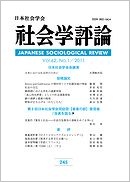Volume 53, Issue 2
Displaying 1-30 of 30 articles from this issue
- |<
- <
- 1
- >
- >|
-
2002Volume 53Issue 2 Pages 2-18
Published: September 30, 2002
Released on J-STAGE: April 23, 2010
Download PDF (1656K) -
2002Volume 53Issue 2 Pages 19-35
Published: September 30, 2002
Released on J-STAGE: October 19, 2009
Download PDF (1807K) -
2002Volume 53Issue 2 Pages 36-51
Published: September 30, 2002
Released on J-STAGE: October 19, 2009
Download PDF (1788K) -
2002Volume 53Issue 2 Pages 52-68
Published: September 30, 2002
Released on J-STAGE: April 23, 2010
Download PDF (1998K) -
2002Volume 53Issue 2 Pages 69-84
Published: September 30, 2002
Released on J-STAGE: October 19, 2009
Download PDF (1584K) -
2002Volume 53Issue 2 Pages 85-101
Published: September 30, 2002
Released on J-STAGE: October 19, 2009
Download PDF (1904K) -
2002Volume 53Issue 2 Pages 102-116
Published: September 30, 2002
Released on J-STAGE: April 23, 2010
Download PDF (1625K) -
2002Volume 53Issue 2 Pages 117-118
Published: September 30, 2002
Released on J-STAGE: October 19, 2009
Download PDF (820K) -
2002Volume 53Issue 2 Pages 125-127
Published: September 30, 2002
Released on J-STAGE: October 19, 2009
Download PDF (354K) -
2002Volume 53Issue 2 Pages 128-129
Published: September 30, 2002
Released on J-STAGE: October 19, 2009
Download PDF (208K) -
2002Volume 53Issue 2 Pages 130-131
Published: September 30, 2002
Released on J-STAGE: October 19, 2009
Download PDF (200K) -
2002Volume 53Issue 2 Pages 131-133
Published: September 30, 2002
Released on J-STAGE: October 19, 2009
Download PDF (313K) -
2002Volume 53Issue 2 Pages 133-135
Published: September 30, 2002
Released on J-STAGE: October 19, 2009
Download PDF (319K) -
2002Volume 53Issue 2 Pages 135-136
Published: September 30, 2002
Released on J-STAGE: October 19, 2009
Download PDF (190K) -
2002Volume 53Issue 2 Pages 136-138
Published: September 30, 2002
Released on J-STAGE: October 19, 2009
Download PDF (302K) -
2002Volume 53Issue 2 Pages 138-139
Published: September 30, 2002
Released on J-STAGE: October 19, 2009
Download PDF (213K) -
2002Volume 53Issue 2 Pages 140-141
Published: September 30, 2002
Released on J-STAGE: October 19, 2009
Download PDF (190K) -
2002Volume 53Issue 2 Pages 142-143
Published: September 30, 2002
Released on J-STAGE: October 19, 2009
Download PDF (212K) -
2002Volume 53Issue 2 Pages 143-145
Published: September 30, 2002
Released on J-STAGE: October 19, 2009
Download PDF (324K) -
2002Volume 53Issue 2 Pages 145-146
Published: September 30, 2002
Released on J-STAGE: October 19, 2009
Download PDF (225K) -
2002Volume 53Issue 2 Pages 147-148
Published: September 30, 2002
Released on J-STAGE: October 19, 2009
Download PDF (206K) -
2002Volume 53Issue 2 Pages 148-150
Published: September 30, 2002
Released on J-STAGE: October 19, 2009
Download PDF (310K) -
2002Volume 53Issue 2 Pages 150-152
Published: September 30, 2002
Released on J-STAGE: October 19, 2009
Download PDF (306K) -
2002Volume 53Issue 2 Pages 152-153
Published: September 30, 2002
Released on J-STAGE: October 19, 2009
Download PDF (210K) -
2002Volume 53Issue 2 Pages 154-155
Published: September 30, 2002
Released on J-STAGE: October 19, 2009
Download PDF (287K) -
2002Volume 53Issue 2 Pages 155-157
Published: September 30, 2002
Released on J-STAGE: October 19, 2009
Download PDF (368K) -
2002Volume 53Issue 2 Pages 157-159
Published: September 30, 2002
Released on J-STAGE: October 19, 2009
Download PDF (323K) -
2002Volume 53Issue 2 Pages 159-161
Published: September 30, 2002
Released on J-STAGE: October 19, 2009
Download PDF (390K) -
2002Volume 53Issue 2 Pages 161-163
Published: September 30, 2002
Released on J-STAGE: October 19, 2009
Download PDF (279K) -
2002Volume 53Issue 2 Pages 165
Published: 2002
Released on J-STAGE: October 19, 2009
Download PDF (31K)
- |<
- <
- 1
- >
- >|
